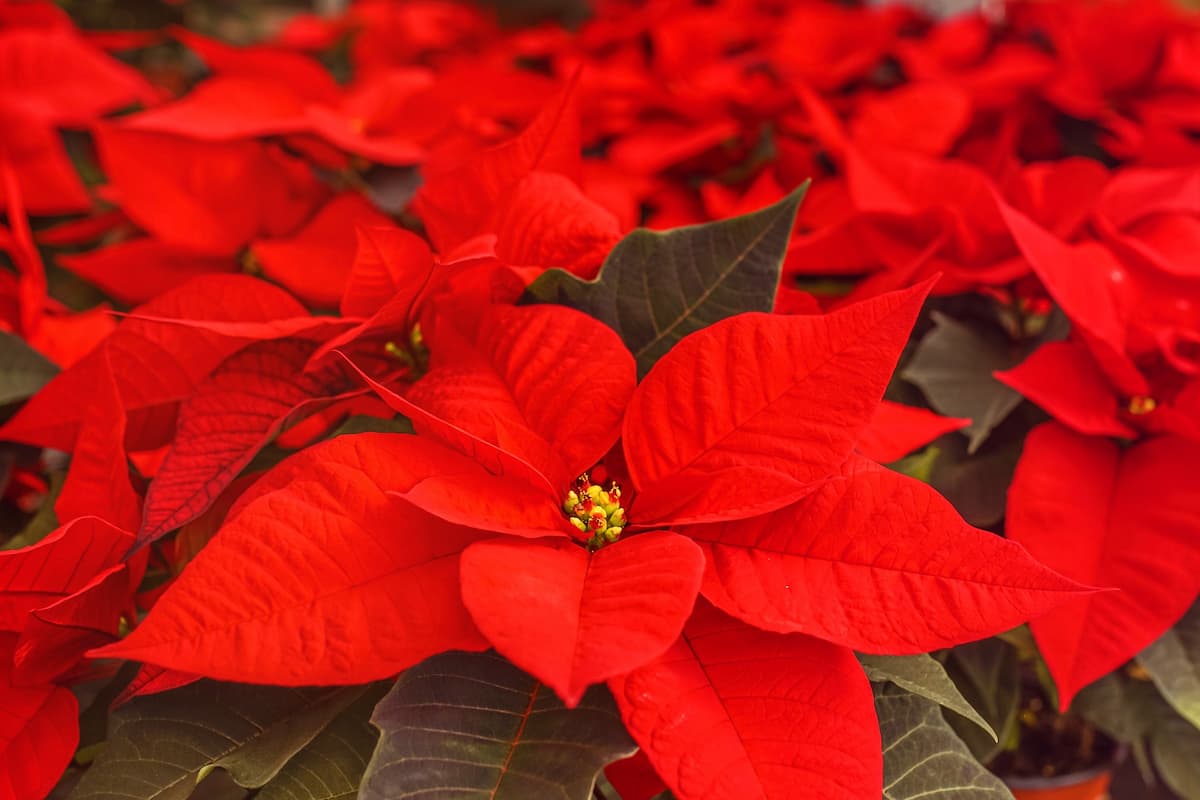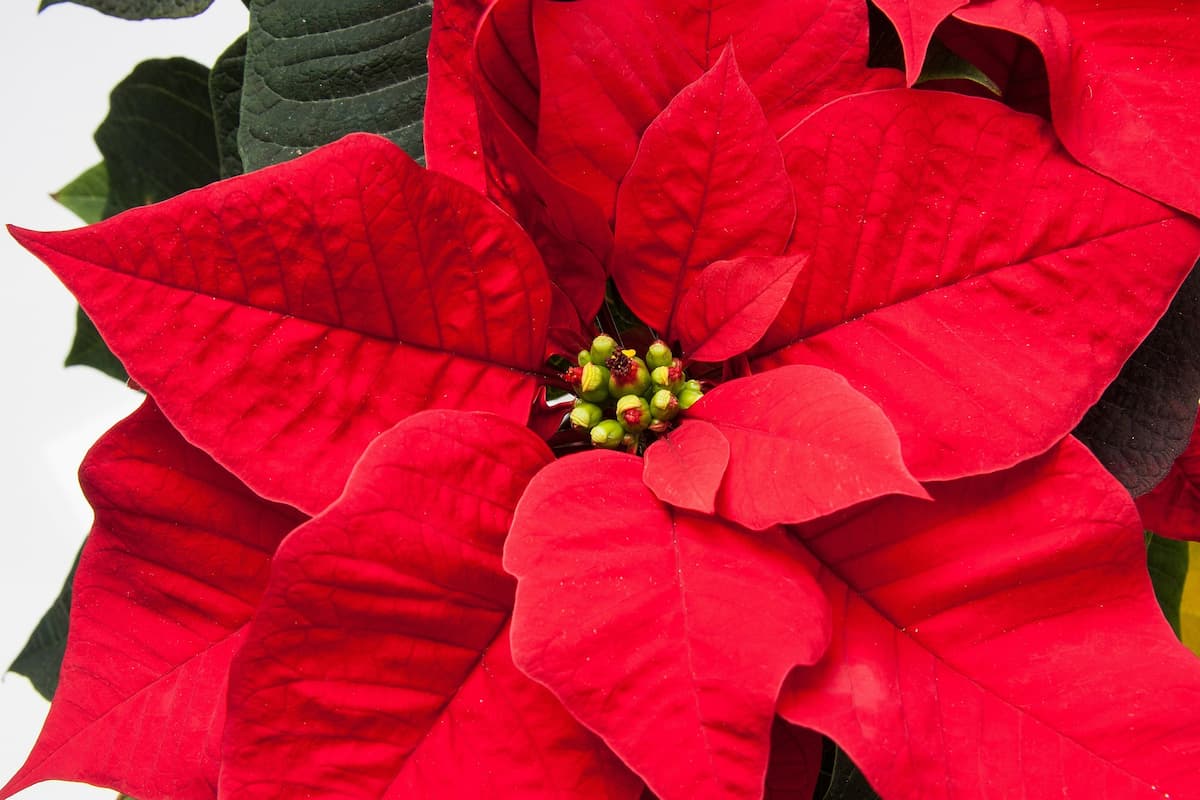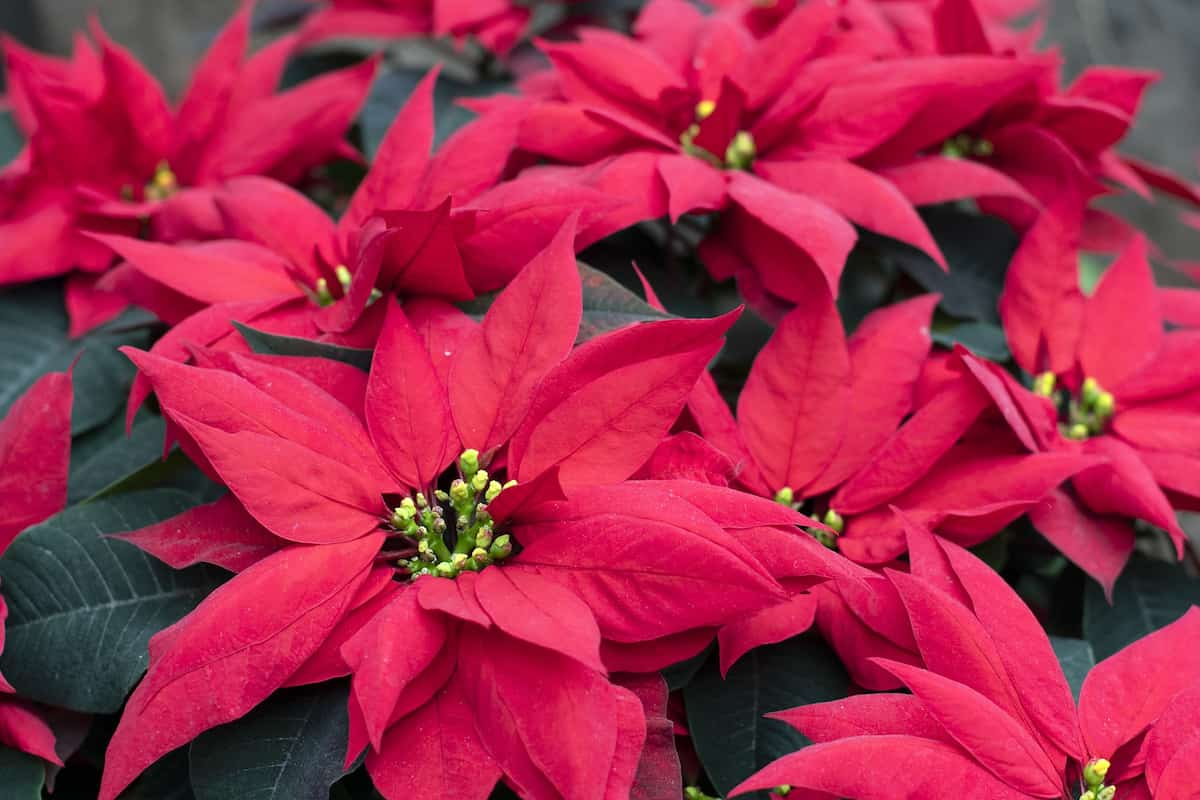Poinsettia plants are among the most popular indoor plants. They come in various colors and are great for adding a splash of color to any room. Poinsettias are easy to grow and thrive in most climates. They are a popular houseplant due in part to their brightly-colored flowers that can last up to a week in a vase. Poinsettias are easy to grow and care for. Just give them plenty of light, water, and fertilizer.

Flowers on Poinsettias likely will vary in appearance depending on the cultivar, but typically they are red, green, or purple and measure 2 to 4 inches across. The plant flowers in late winter or early spring. There is no set rule when a particular cultivar flowers; it depends on its growth pattern. They’re easy to care for and provide beautiful flowers year-round. There are several different types of Poinsettia plants, each with unique features.
How to grow and care for poinsettia indoors
Types of Poinsettia
- Plum pudding – Plum pudding is a type of Poinsettia plant that typically has red or pink flowers. This type of Poinsettia is popular for its decorative leaves and flowers.
- Alaska White – There are many Poinsettia plants, each with a unique look and personality. The Alaska white Poinsettia is the perfect choice for a bold-looking plant that will brighten up any room. This variety of Poinsettia is best known for its large, brightly-colored blooms reminiscent of snowflakes.
- Jingle Bell Rock – There are many Poinsettia plants, each with special features. The most common type is the indoor plant, which can be grown in a pot or on a windowsill. Other types include the jingle bell rock, which has bright red flowers.
- Lemon Drop – Lemon Drop is a Poinsettia plant with bright green leaves and blooms with a beautiful white flower. The Lemon Drop is popular for indoor plants because of its attractive appearance and easy care.
- Candy Cinammon – Poinsettia plants come in various colors, including red, green, yellow, and white. Some people prefer white Poinsettias because they are more difficult to grow than other colors. The most popular type of Poinsettia is the candy cane Poinsettia. The candy cane Poinsettia is available in various colors, from bright pink to deep purple. The stems are usually long and thin, and the leaves are small and pointed. Candy cane Poinsettias are easy to grow and require little care. They can be placed in a sunny spot or grown indoors in a pot or container.
Climate suitable for growing Poinsettia
Poinsettia plants are best grown in well-drained soil with a pH of 6.5 to 7.5. These plants, like full sun or partial shade, can be watered regularly with room temperature water or a diluted Epsom salt solution. Poinsettia leaves will turn yellow and drop if the plant is not getting enough light, so you’ll need to check on them every day or so during the growing season and adjust your lighting accordingly.
Poinsettia plants need direct sunlight for the best growth and maximum bloom. If your home does not have windows that allow full sun exposure, you can still grow Poinsettias by placing them in a sunny spot outdoors during the early summer months. Poinsettia plants can also be grown in containers indoors.
In case you missed it: How to Grow and Care for Arrowhead Vines Indoors

Soil requirement for growing Poinsettia
Poinsettia needs partial shade and well-drained soil. To successfully grow Poinsettia plants indoors, you must provide ample sunlight. If your windows do not offer enough natural light, you can supplement your plant’s sun exposure with artificial light sources such as fluorescent lights or sunshine.
Soil requirements for growing Poinsettia indoors are fairly simple. Poinsettias prefer well-draining soil high in organic matter and will do best in a location with some partial shade. Avoid soil that is too sandy or heavy, as these conditions will not allow the plant to develop deep roots.
Water requirement for growing Poinsettia
Poinsettia plants need a lot of water to grow and thrive. Usually, they need between 1 and 2 gallons of water per week during the growing season, but it is best to check the specific plant’s watering requirements before you water them. Ensure your pot has good drainage and the soil isn’t too wet or too dry. Water is essential for the growth of Poinsettia plants. Always water your plant regularly, especially when the weather is hot and dry. You should also water your plant consistently so the roots can get the needed moisture.
A good way to measure how much water your plant needs is to stick your finger into the soil at a depth of two inches and feel if it’s wet or dry. Water your plant when you can see that the soil surface is moist but not wet. Do not over-water your plant, as this will cause root rot. Give your plant a good watering schedule at least once per week during the growing season, and keep the soil moist but not soggy. You can occasionally mist your plants with water to help them stay hydrated.
Pot size required for growing Poinsettia
The pot size required for growing Poinsettia indoors is 3 to 6 inches in diameter. Poinsettias like a moist, well-drained soil mix, but they will also do well in slightly acidic soil. The plant can tolerate some drought but prefers consistent moisture levels. As with most plants, regular deadheading will help control height and keep the foliage clean.
In case you missed it: How to Grow and Care for Cyclamen Indoors: A Beginners Guide

Propagating Poinsettia
From cuttings
Poinsettias are easy to propagate from cuttings taken in the early spring. Propagating Poinsettia from cuttings can be a fun and easy way to add holiday cheer to your home. Poinsettia is easy to plant to propagate from cuttings. You can take from a healthy stem and insert it into moist soil.
Take a stem measuring 8 inches long and snap off a shoot near the base. Ensure the cutting is at least 1/2 inch below the soil’s surface. Water the cutting well and insert it into fertile, moist soil. Give it a light watering and wait until new growth appears; this could take as little as a few days or up to several weeks. Once new growth has appeared, repot in a larger container and give the plant another watering.
From seeds
Poinsettias come from tropical plants and need temperatures above 10°C to germinate. Place the Poinsettia seed in moist soil and water regularly. When the Poinsettia seedlings are about two inches tall, prick them with a sharp knife and transfer them to a pot. Give the plants plenty of light and water when needed. The Poinsettia will bloom in late winter or early spring.
In case you missed it: Over Fertilization Symptoms of Indoor Plants and How to Fix It

Poinsettia plant care
Fertilizer requirement for growing Poinsettia
Growing Poinsettia plants indoors is a popular way to enjoy the beautiful flowers year-round. However, you know a few things before beginning your indoor Poinsettia growing adventure. First, these plants require regular fertilization to maintain their health and vigor. Second, ensure that the soil you use is well-draining and has good aeration. Finally, keep your plants watered, especially during dry periods.
Poinsettia plants are often grown as houseplants but can also be grown outdoors. The Poinsettia plant needs fertilizer to grow properly. Different fertilizers are necessary for different types of plants, so it is important to read the product label before using it. Poinsettia plants need a fertilizer with high nitrogen levels. A general all-purpose plant fertilizer will work well. Apply the fertilizer every two to three weeks during the growing season or when new growth begins.
With abundant light, fresh air, and water available, Poinsettia growing can be relatively easy. Choose a good potting soil mix specifically made for Poinsettias. Make sure it is well-draining and contains enough organic matter. Water your plants regularly, especially during dry periods using room-temperature water to prevent overwatering and root rot. Avoid using harsh chemicals or fertilizers when watering your plants; these can damage leaves and flowers.
In case you missed it: Reasons Why Indoor Plant Leaves Turn Yellow and How to Fix It

Poinsettia plant care in winter
Poinsettias are popular houseplants but do well in cold climates. When growing Poinsettia plants indoors, you need to provide them with the same light and water they would get outdoors. You can also give them a little fertilizer every month if needed. During the winter months, prune it regularly, so it doesn’t become overgrown and spindly. If your Poinsettia starts showing signs of disease or decay, remove it from the home immediately.
Poinsettia plants are some of the most popular indoor plants for a good reason. They are easy to grow, tolerant of various conditions, and come in various colors. Poinsettias also make great holiday decorations. If you choose to grow your plants, give them adequate water and fertilizer during winter. Keep the plant away from drafts and cold temperatures, which can cause it to drop its leaves. To keep your Poinsettia fresh all winter long, fertilize it every two weeks in late winter and early spring. During the summer, stop fertilizing it altogether and water only when necessary.
Pruning Poinsettia plant
Picking the right time to prune Poinsettia plants is important to keep them healthy and to look their best. You should wait until the new growth has stopped, usually around late winter or early spring. One of the most important things you can do to keep your Poinsettia healthy is to prune it regularly. Begin by removing any dead or diseased branches in the early stages of growth. Then, continue to trim back the leaves at regular intervals as they start to yellow and fall off.
These plants are easy to care for, have long blooming periods, and can be colorful year-round. Once a month, take a few minutes to clean up all of the old leaves and flowers from the plant. This will help keep it looking fresh and new. Be sure to water it well after fertilizing. If your plant starts growing too much foliage, thin out some unwanted growth by cutting off about one-fourth of the stem at the soil level.
Repotting Poinsettia plant
Poinsettia plants cannot tolerate too low or too high pH water. To repot a Poinsettia plant, first make sure the pot it is in has good drainage and is large enough for the roots to spread out. Next, use a sharp knife to cut off the old soil around the stem of the Poinsettia and remove any rocks or roots buried in the soil. Gently pull out the old roots and replace them with fresh potting soil. Make sure that the soil is evenly moistened before repotting.
In case you missed it: Indoor Plants That Can Be Used as Christmas Tree Alternatives

Pests and diseases of Poinsettia plant and their control
Poinsettias are susceptible to several pests, including aphids, spider mites, and mealybugs. Aphids are the most common pest of Poinsettias and can be controlled with various insecticides. Spider mites reproduce quickly and must be killed as soon as they are detected. Mealybugs feed on the sap of Poinsettias, causing leaves to curl and droop. The best way to control mealybugs is to treat the plant with an insecticidal soap or pesticide before it becomes a problem.
Poinsettias are grown as house plants in temperate zones around the world. Many diseases can affect Poinsettias, but most are relatively easy to control with proper care. Poinsettias should be kept dry and warm; they need good sunlight and a humid environment to thrive. Rot is a common problem with Poinsettias, especially if they’re not watered sufficiently. Fungal infections can also be a problem, so cleaning up debris regularly is important.
Conclusion
Poinsettias are the most popular holiday plants and for a good reason. They’re easy to care for, look great in any home, and bring beauty to any room. But before you can start enjoying your Poinsettia plants, you need to know how to grow them. If you’re looking for a plant that is beautiful and easy to care for, choose Poinsettia. These plants can be grown indoors in most climates and are especially happy when given plenty of light and water.
- How to Grow Hibiscus from Flower
- Plantation Ideas for Home Decoration: A Beginners Guide
- Flower Garden Designs and Layouts for Beginners
- Planting and Spacing Techniques in Papaya: A Beginner’s Guide
- Growing Gold: Essential Techniques for Planting Pineapples
- How to Make Kalanchoe Plant Bushy: Home Remedies and Solutions
- 11 Reasons Why Your Gardenia is Not Blooming: Home Remedies and Solutions
- Eco Elegance: The Guide to Designing a Drought-Tolerant Landscape
- Gardening on a Slope: Strategies for Hillside Landscaping
- Nourish and Flourish: Top Organic Mulches for Thriving House Plants
- Everything You Want to Know about Indian Mogra Flower: Discover Uses and Growing
- Green Thumb Success: Expert Tips for Cultivating Greenhouse Pumpkins All Year Round
- Maximize Growth & Flavor: The Ultimate Guide to Companion Planting in Herb Gardens
- How to Control Rhododendron Problems Naturally: Home Remedies and Organic Ways to Fix Them
- Natural Magic: The Remarkable Benefits of Cinnamon for Plants
- Best Steps to Revive Dying Tulip with Natural and Organic Treatment
- 10 Reasons Why Your Angel Trumpet is Not Blooming: Remedies and Treatment
- How to Fix Periwinkle Leaf and Flower-Related Problems: Natural Remedies and Solutions
- How to Fix Zinnias Leaf and Flower Problems: Discover Natural and Home Remedies
- Organic Steps to Induce Lemon Tree Flowers: A Comprehensive Guide
- Bloom Booster: Crafting the Perfect Homemade Bougainvillea Fertilizer
- Optimizing Growth: A Guide to Applying NPK Fertilizer for Potted Plants
- 10 Best Homemade Fertilizers for Rubber Plant: DIY Recipes and Application Method
- How to Boost Female Pumpkin Flowers: Effective Steps for More Flowers and High Yields
- Transform Your Indoor Garden: Top Benefits of Pink Salt for Houseplants
- 10 Best Homemade Fertilizers for Peacock Plants (Calathea): Easy DIY Guide
- Unlock Blooms: 9 Reasons Why Your Potted Chrysanthemum is Not Blooming
- 8 Reasons Why Your Potted Hibiscus is Not Blooming: Fix it with Simple Solutions
- Unlock Blooms: 9 Key Reasons Your Potted Frangipani Won’t Flower
- 10 Reasons Why Is My Ice Plant Not Blooming: Remedies and Treatment
- 10 Reasons Why My Potted Hydrangea Not Blooming: Treatment and Remedies
- 10 Reasons Why is My Wisteria Not Blooming: Remedies and Treatment
- 10 Reasons Why is My Goldfish Plant Not Blooming: Remedies and Treatment
- Maximize Your Space: Ultimate Guide to Balcony Gardening with Grow Bags
- 10 Reasons Why Your Iris is Not Blooming: Remedies and Treatment
- 10 Reasons Why Your Anthurium Plant is Not Blooming: Treatment and Remedies